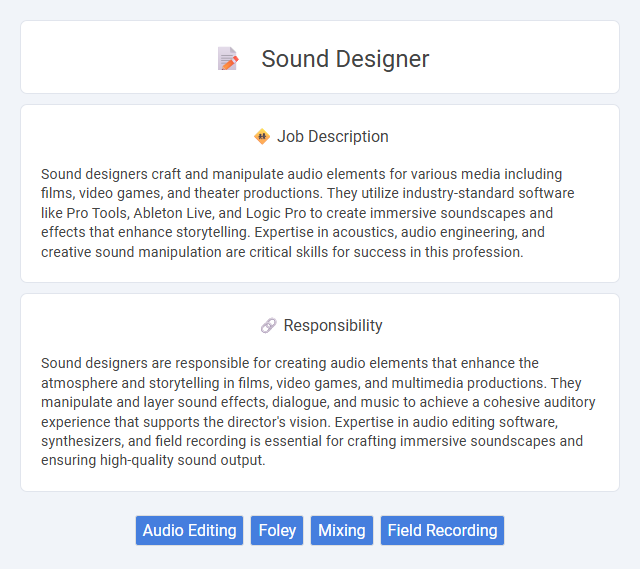
Sound designers craft and manipulate audio elements for various media including films, video games, and theater productions. They utilize industry-standard software like Pro Tools, Ableton Live, and Logic Pro to create immersive soundscapes and effects that enhance storytelling. Expertise in acoustics, audio engineering, and creative sound manipulation are critical skills for success in this profession.
Individuals with a strong auditory sensitivity and a passion for creative experimentation are more likely to excel as sound designers. Those who thrive in environments requiring attention to detail, patience, and technical proficiency may find this profession well-suited to their skills. Conversely, people easily distracted or uncomfortable with repetitive tasks might face challenges adapting to the demands of sound design work.
Qualification
Sound designers must possess advanced skills in audio editing software such as Pro Tools, Logic Pro, and Ableton Live, alongside a solid understanding of acoustics and audio engineering principles. Proficiency in sound synthesis, Foley techniques, and spatial audio design is essential for creating immersive auditory experiences. A background in music production, film, or game audio, combined with strong creative instincts and technical expertise, significantly enhances a sound designer's qualification profile.
Responsibility
Sound designers are responsible for creating audio elements that enhance the atmosphere and storytelling in films, video games, and multimedia productions. They manipulate and layer sound effects, dialogue, and music to achieve a cohesive auditory experience that supports the director's vision. Expertise in audio editing software, synthesizers, and field recording is essential for crafting immersive soundscapes and ensuring high-quality sound output.
Benefit
Sound designers likely benefit by creating immersive audio experiences that enhance storytelling and user engagement in various media. They often gain opportunities to collaborate with creative teams, fostering diverse skill development and professional growth. Strong demand in gaming, film, and advertising industries suggests a stable career path with potential for financial reward.
Challenge
Sound designers likely face the challenge of creating immersive audio experiences that complement visual elements without overpowering them. Balancing creativity with technical constraints might require innovative problem-solving and adaptability. The probability of encountering tight deadlines and evolving project requirements can add pressure to maintain both quality and efficiency.
Career Advancement
Sound designers advance their careers by mastering audio engineering software, expanding expertise in sound synthesis, and honing skills in various media formats like film, gaming, and virtual reality. Building a strong portfolio showcasing diverse projects and networking with industry professionals can lead to senior roles such as lead sound designer or audio director. Continuous learning of emerging technologies like spatial audio and immersive soundscapes enhances opportunities for higher-level positions and creative leadership.
Key Terms
Audio Editing
Sound designers specializing in audio editing manipulate and enhance recorded sounds to create polished, immersive auditory experiences for films, games, and media. They utilize advanced software like Pro Tools, Adobe Audition, and Logic Pro to edit dialogue, sound effects, and ambient noises with precision and creativity. Mastery of techniques such as noise reduction, equalization, and layering is crucial for producing clear, balanced audio that aligns seamlessly with visual elements.
Foley
A sound designer specializing in Foley creates realistic audio effects by recording everyday sounds that synchronize with on-screen actions, enhancing the immersive experience of films, video games, and animations. This role requires expertise in acoustics, creative use of props, and precise timing to match footsteps, cloth rustling, and other ambient noises. Foley artists collaborate closely with directors and sound editors to ensure that every sound element contributes to the narrative's emotional and sensory impact.
Mixing
Sound designers specializing in mixing combine multiple audio elements to create a balanced and immersive soundscape for films, games, and music productions. They utilize advanced digital audio workstations (DAWs) such as Pro Tools, Logic Pro, and Ableton Live to adjust levels, EQ, and effects, ensuring clarity and emotional impact. Expertise in spatial audio, dynamic range compression, and reverb techniques enhances the overall auditory experience, making their role crucial in post-production and live sound environments.
Field Recording
Sound designers specializing in field recording capture authentic environmental sounds and ambient noise to create immersive audio experiences for film, video games, and multimedia projects. They use high-quality microphones and portable recorders to gather diverse soundscapes, enabling precise manipulation and layering during post-production. Mastery of acoustic properties and location scouting ensures the capture of clean, contextually relevant audio that enhances storytelling and audience engagement.
 kuljobs.com
kuljobs.com